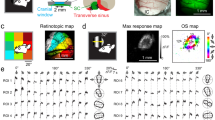Abstract
MORE than 30 years after Hubel and Wiesel1 first described orientation selectivity in the mammalian visual cortex, the mechanism that gives rise to this property is still controversial. Hubel and Wiesel1 proposed a simple model for the origin of orientation tuning, in which the circularly symmetrical receptive fields of neurons in the lateral geniculate nucleus that excite a cortical simple cell are arranged in rows. Since this model was proposed, several experiments2–6 and neuronal simulations7,8 have suggested that the connectivity between the lateral geniculate nucleus and the cortex is not well organized in an orientation-specific fashion, and that orientation tuning arises instead from extensive interactions within the cortex. To test these models we have recorded visually evoked synaptic potentials in simple cells while cooling the cortex9, which largely inactivates the cortical network, but leaves geniculate synaptic input functional. We report that the orientation tuning of these potentials is almost unaffected by cooling the cortex, in agreement with Hubel and Wiesel's original proposal1.
This is a preview of subscription content, access via your institution
Access options
Subscribe to this journal
Receive 51 print issues and online access
$199.00 per year
only $3.90 per issue
Buy this article
- Purchase on Springer Link
- Instant access to full article PDF
Prices may be subject to local taxes which are calculated during checkout
Similar content being viewed by others
References
Hubel, D. H. & Wiesel, T. N. J. Physiol., Lond. 160, 106–154 (1962).
Blakemore, C. & Tobin, E. A. Expl Brain Res. 15, 439–440 (1972).
Creutzfeldt, O. D., Kuhnt, U. & Benevento, L. A. Expl Brain Res. 21, 251–274 (1974).
Sillito, A. M. J. Physiol., Lond. 250, 305–329 (1975).
Crook, J. M., Eysel, U. T. & Machemer, H. F. Neuroscience 40, 1–12 (1991).
Kisvarday, Z. F., Kim, D. S., Eysel, U. T. & Bonhoeffer, T. Eur. J. Neurosci. 6, 1619–1632 (1994).
Douglas, R. J. & Martin, K. A. C. J. Physiol., Lond. 440, 735–769 (1991).
Somers, D. C., Nelson, S. B. & Sur, M. J. Neurosci. 15, 5448–5465 (1995).
Kalil, R. E. & Chase, R. J. Neurophysiol. 33, 459–474 (1970).
Gilbert, C. D. & Kelly, J. P. J. comp. Neurol. 163, 81–105 (1975).
Ferster, D. & Lindström, S. J. Physiol., Lond. 367, 233–252 (1985).
LeVay, S. & Gilbert, C. D. Brain Res. 113, 1–19 (1976).
Gilbert, C. D. & Wiesel, T. N. Nature 280, 120–125 (1979).
Hubel, D. H. & Wiesel, T. N. J. Neurophysiol. 28, 229–289 (1965).
Shatz, C. J. J. comp. Neurol. 173, 497–518 (1977).
Ferster, D. J. Neurosci. 6, 1284–1301 (1986).
Douglas, R. J., Martin, K. A. C. & Whitteridge, D. Nature 332, 642–644 (1988).
Ferster, D. & Jagadeesh, B. J. Neurosci. 12, 1262–1274 (1992).
Nelson, S., Toth, L., Sheth, B. & Sur, M. Science 265, 774–777 (1994).
Douglas, R. J., Koch, C., Mahowald, M., Martin, K. A. C. & Suarez, H. H. Science 269, 981–985 (1995).
Saul, A. B. & Humphrey, A. L. J. Neurophysiol. 64, 206–224 (1990).
Maex, R. thesis, Katholieke Univ. Leuven (1994).
Suarez, H., Koch, C. & Douglas, R. J. Neurosci. 15, 6700–6719 (1995).
Tanaka, K. J. Neurophysiol. 49, 1303–1318 (1983).
Reid, R. C. & Alonso, J.-M. Nature 378, 281–284 (1995).
Jones, J. P. & Palmer, L. A. J. Neurophysiol. 58, 1187–1211 (1987).
Chapman, B., Zahs, K. R. & Stryker, M. P. J. Neurosci. 11, 1347–1358 (1991).
Chapman, B. & Stryker, M. P. J. Neurosci. 13, 5251–5262 (1993).
Miller, K. D. J. Neurosci. 14, 409–441 (1994).
Schwark, H. D., Malpeli, J. G., Weyand, T. G. & Lee, C. J. Neurophysiol. 56, 1074–1087 (1986).
Author information
Authors and Affiliations
Rights and permissions
About this article
Cite this article
Ferster, D., Chung, S. & Wheat, H. Orientation selectivity of thalamic input to simple cells of cat visual cortex. Nature 380, 249–252 (1996). https://doi.org/10.1038/380249a0
Received:
Accepted:
Issue Date:
DOI: https://doi.org/10.1038/380249a0
This article is cited by
-
The logic of recurrent circuits in the primary visual cortex
Nature Neuroscience (2024)
-
Waves traveling over a map of visual space can ignite short-term predictions of sensory input
Nature Communications (2023)
-
The evolutionary origin of visual and somatosensory representation in the vertebrate pallium
Nature Ecology & Evolution (2020)
-
Propofol Resistance of Functional Domains with Orientation and Direction Sensitivity of the Primary Visual Cortex in Rats
Neuroscience and Behavioral Physiology (2020)
-
A repeated molecular architecture across thalamic pathways
Nature Neuroscience (2019)
Comments
By submitting a comment you agree to abide by our Terms and Community Guidelines. If you find something abusive or that does not comply with our terms or guidelines please flag it as inappropriate.



